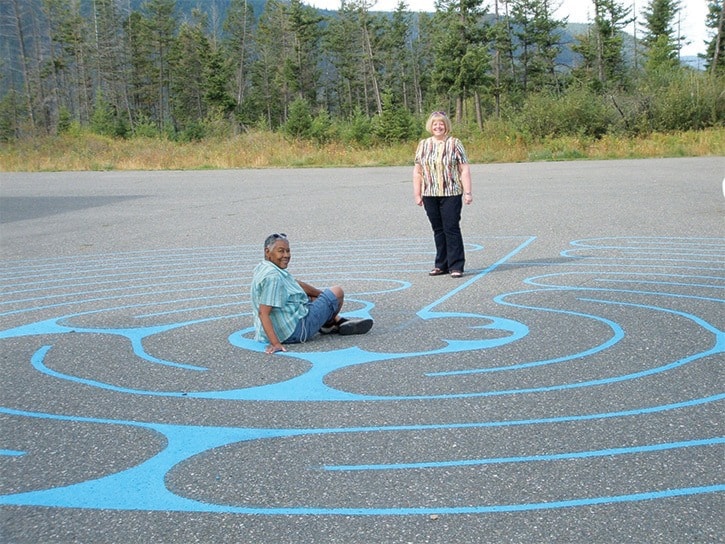Williams Lake now has its very own labyrinth.
Since ancient times labyrinths have been pilgrimage destinations around the world for people seeking spiritual enlightenment, answers to life’s many questions, or simply to gain some quiet time between a busy day job and retiring home for the evening.
Not to be confused with a maze that is designed as a puzzle to solve, the user can’t get lost in a labyrinth, say Maureen Margetts and Mary Trott who put the last touches of paint on their two-year project last week.
“There is no correct way to use a labyrinth,” Margetts says.
She says some people crawl on their hands and knees in acts of devotion, some people dance, some people walk quickly, while others walk the path very slowly.
The lakecity’s labyrinth is patterned after the beautiful Chartres Cathedral Labyrinth in France and is about 57 feet across, Margetts says.
The walk is about a quarter of a kilometre to the centre and the same distance out again. Depending on how fast you move the labyrinth takes half an hour to an hour to complete.
Walking and talking through the labyrinth last week with Margetts and Trott, it seemed at one point that we would never get to the centre and out again.
But to the centre and out again we walked.
“That’s where trust comes in,” Trott says.
The best time to walk the labyrinth is in the early morning or in the early evening, say Trott and Margetts.
Trott says people have their favourite ways to centre themselves before they enter a labyrinth. They may focus on their breathing, meditate, or perhaps smudge.
They may use it to work through fear or grief, find inspiration for a creative project, unwind after a busy day, or as a quiet time to work on a problem for which they are seeking an answer.
If you are asking a question the women say it is best to go into the labyrinth with an open mind otherwise you may get the answer you want, but not the answer you may need.
“Even with the best of intensions you may get no answer at all,” Trott cautions.
While we were walking the labyrinth, first a young buck, then a female deer, wandered past us in the forest at the edge of the St. Andrew’s Church parking lot on Huckvale Place where the labyrinth is located.
According to their research a deer is a symbol of the female spirit, so it felt quite uplifting to be in that spiritual space with the two women.
The birth of a labyrinth
Margetts and Trott say they share a common interest in the history and use of labyrinths around the world, and are following the dream of a fellow St. Andrew’s parishioner, who was hoping to create a labyrinth for Williams Lake, but is now studying to become a minister.
“I have always been fascinated with labyrinths and so was Mary,” Margetts says.
She says the beautiful Chartres pattern they chose for the labyrinth has a rose at the centre which has a number of meanings.
The rose symbolizes Mother Mary; enlightenment; the holy spirit; the six days in which God created the universe; the six stages of evolution; the six realms or kingdoms (mineral/crystal, plant, animal, human, angelic, or unknown — God or whomever you believe in).
Making the labyrinth was both a mental and physical exercise for the women.
“It was an exercise in patience and concentration,” Trott says.
Margetts adds: “I was very happy with how well we worked together.”
Trott and Margetts started researching and working on their labyrinth two years ago.
With some physical labour and help from friends to clean and prepare the surface in the spring of 2012, and again this spring, the duo used rudimentary tools to create the design on the pavement. A spare tire set at the centre attached to a rope and a stick fixed with chalk was used to mark out the initial circles. Part of a venetian blind was use to create the curved sections. After chalking in the lines they used a two-inch roller on a stick to paint in the lines using the weather hardy blue seen on handicapped parking spaces.
They were careful to make the walk wide enough to accommodate wheelchairs.
“It was a lot of work,” Margetts admits.
“It’s not mathematical precision, I can tell you that,” Trott adds.
While the labyrinth is painted on the parking lot behind St. Andrew’s United Church, they say it is open for everyone to use, regardless of faith. It is a way to create a connection between your mind, body, and spirit, they say.
Except when there are special occasions such as weddings or funerals, the parking lot where the labyrinth is painted, in the same street-hardy blue that is used to mark disabled parking spaces, is usually available for people to use.
